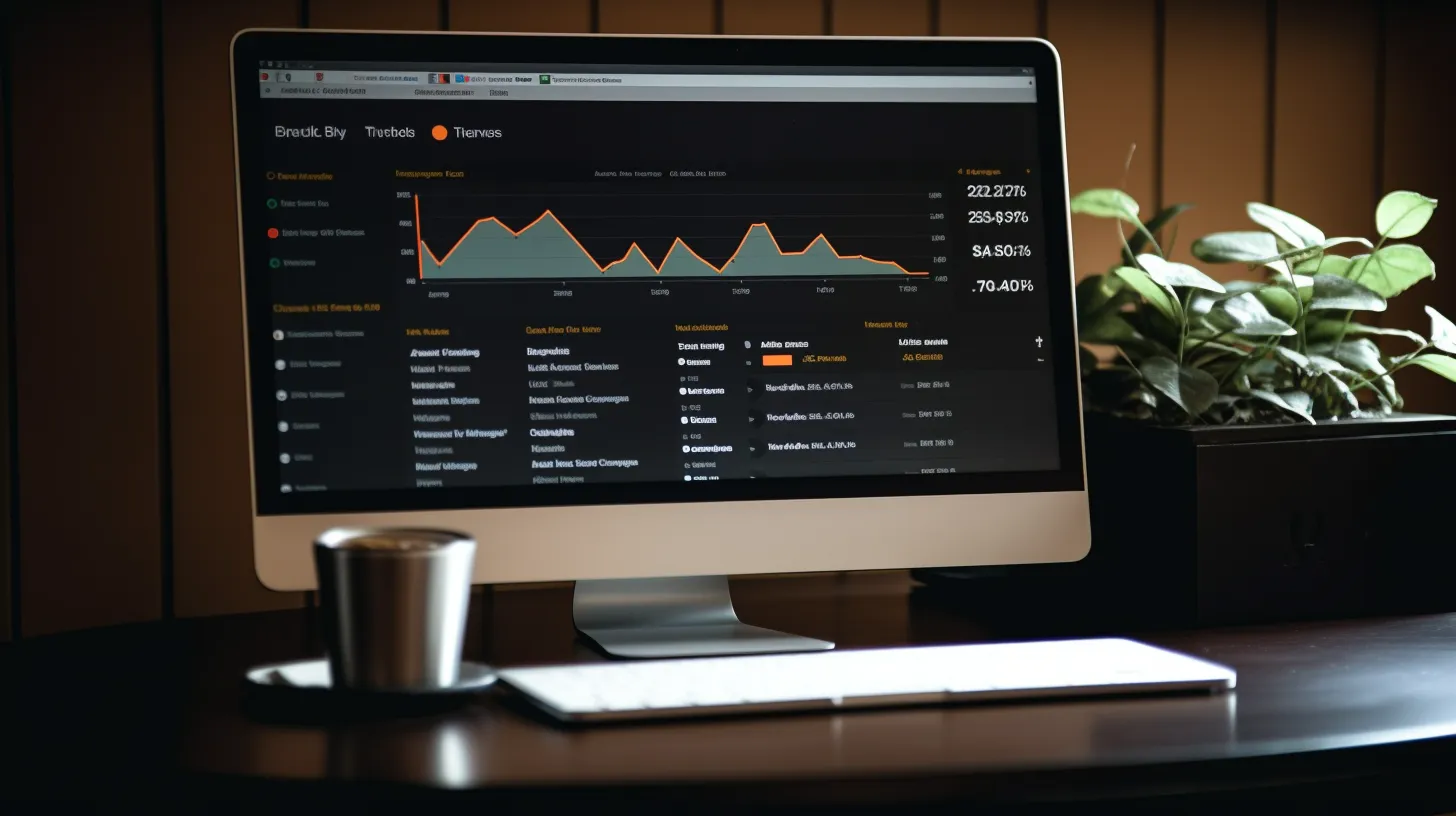How To Use Google Analytics For SEO: A Comprehensive Guide
Google Analytics is an essential tool for any business that seeks to optimize its search engine optimization (SEO) strategy. However, the platform can be overwhelming and confusing, particularly for those who are new to SEO. This comprehensive guide will provide a step-by-step approach on how to use Google Analytics effectively for SEO purposes.
The guide will cover everything from understanding the basics of Google Analytics, setting up your account, configuring settings, tracking website traffic, analyzing data and creating reports. Additionally, we’ll explore advanced techniques such as using custom segments and filters to analyze user behavior more deeply. By the end of this article, you should have a clear understanding of how to leverage Google Analytics in your SEO efforts and gain valuable insights into your website’s performance.
Understanding The Basics Of Google Analytics
Google Analytics is a powerful tool that can provide website owners with valuable insights into how their site is performing. By analyzing data from various sources, Google Analytics allows users to track metrics such as traffic volume, user behavior, and conversion rates. This information can help businesses improve their online presence by identifying areas for improvement and making informed decisions about marketing strategies.
One of the benefits of using Google Analytics is its ability to track website performance over time. Users can monitor changes in key metrics such as bounce rate, page views, and time on site to identify trends that may be impacting overall performance. This data can then be used to make adjustments to content or design elements in order to improve engagement and increase conversions.
In addition to tracking user behavior on your own website, Google Analytics can also provide insight into how visitors are finding your site through search engines. The platform offers tools for monitoring keyword rankings and assessing the effectiveness of SEO efforts. By leveraging this data, businesses can refine their approach to search engine optimization and drive more targeted traffic to their site.
Setting Up Your Google Analytics Account
- Google Analytics can be used to track website performance and user behaviour.
- Creating an account in Google Analytics requires a Google account and granting access to the Analytics service.
- Linking your website to Google Analytics can be done by embedding the Google Analytics tracking code onto each page of your website.
- Setting up goals in Google Analytics involves defining an action that you would like the users to take on your website.
- Filters can be used to customize the data that is being collected and reported in Google Analytics.
- It is important to set up filters before collecting any data in order to ensure that the data is accurate and reliable.
Creating An Account
Setting up your Google Analytics account is an essential step towards understanding how users interact with your website. It provides you with valuable insights that can be used to improve the user experience and drive more traffic to your site. To set up your account, the first thing you need to do is create a Google Analytics account.
Integrating Google Tag Manager into your analytics setup is crucial for tracking data accurately on your website. By using GTM, you'll have better control over the tags placed on your site, allowing you to track specific events like form submissions or button clicks easily. Ensure that it's integrated correctly by following the instructions provided in the GTM documentation.
Troubleshooting common setup issues is necessary when creating a Google Analytics account. Some of these problems include incorrect tracking codes, missing pages or views, slow loading speed among others. Familiarize yourself with these issues and their solutions before setting up your GA account. This way, you'll avoid any errors that could cause inaccurate reporting of data on your website.
Linking Your Website
Setting up your Google Analytics account and integrating GTM are essential steps towards tracking data accurately on your website. However, another crucial aspect is linking your website to GA. Linking allows you to access more detailed information about your site's performance, such as traffic sources from social media or other websites.
One way to increase the number of sites that link back to yours is through backlink building. It involves creating high-quality content that naturally attracts links from authoritative websites in your industry. Another strategy is internal linking, which refers to adding links within your site's pages that direct users to other relevant content on your website.
When it comes to linking your website to GA, there are two methods: using a tracking code or connecting through Google Tag Manager. The former requires inserting a tracking ID into each page of your site manually, while the latter involves setting up a tag with GTM and then configuring it with GA settings. Both approaches have their advantages and disadvantages, so choose the one that best suits your needs based on factors like ease of use and flexibility.
In summary, linking your website to Google Analytics is critical for gaining insights into its performance. By implementing effective backlink building and internal linking strategies, you can attract more visitors and improve user experience on your site. Whether you decide to use a tracking code or connect via GTM, make sure to follow proper instructions carefully for accurate reporting of data on your website.
Setting Up Goals & Filters
Once you have linked your website to Google Analytics, the next step is to set up goals and filters. Goal tracking allows you to measure specific actions that users take on your site, such as completing a purchase or filling out a form. By setting up goals, you can track the effectiveness of your marketing campaigns and identify areas for improvement.
Filters are another essential feature of GA that allow you to exclude certain data from your reports. For example, if you want to exclude traffic from internal IP addresses or filter out spam referrals, you can create custom filters in GA settings. Filter exclusions ensure that your data is accurate and reliable when making business decisions based on analytics insights.
To set up goals and filters in GA, navigate to the Admin section of your account and select Goals or Filters. From there, follow the prompts to define your goal type or create a new filter exclusion rule. It's important to carefully consider which metrics matter most for achieving your business objectives and tailor your goals accordingly. Similarly, choose filtering options wisely based on factors like data quality and relevance to avoid skewing results unnecessarily.
In conclusion, setting up goals and filters is an integral part of optimizing performance measurement using Google Analytics. By defining clear objectives and excluding irrelevant data from analysis, businesses can gain valuable insights into their customers' behavior and improve their online presence effectively over time. Whether it's through goal tracking or filter exclusions, careful attention must be given before implementing these features for maximum efficiency in reporting website data accurately.
Configuring Your Google Analytics Settings For Seo
Moving on from setting up your Google Analytics account, it's time to configure the settings that are relevant for SEO. The first step is conducting keyword research which involves identifying the phrases and terms that users enter into search engines when looking for products or services similar to yours. This information will help you understand what potential customers are searching for and how they formulate their queries.
The next essential aspect of configuring Google Analytics settings for SEO is focusing on On-page optimization. This technique refers to measures taken directly within a website such as improving page titles, meta descriptions, header tags, and content quality so that they align with targeted keywords. By optimizing these elements, search engines can better comprehend what each page is about and rank them accordingly in search results pages.
Overall, properly configured Google Analytics settings play an integral role in achieving SEO success. Conducting thorough keyword research helps businesses determine the most effective way to reach their target audience while on-page optimization ensures that websites meet user intent and rank higher in search engine results pages. With this knowledge at hand, businesses can take actionable steps toward creating high-quality web content optimized for search engines without compromising the user experience.
Tracking Website Traffic With Google Analytics
- Setting up Google Analytics involves creating an account and adding tracking code to the website, which allows the user to collect data from various sources.
- Analyzing website traffic data requires an understanding of the types of data that are collected, such as numbers of visits and the sources of visits, which helps the user better understand their audience.
- An analysis of website traffic data can be used to determine the effectiveness of marketing campaigns, optimize content, and create targeted campaigns to improve website performance.
- Additionally, analyzing website traffic data allows the user to compare their performance to competitors, as well as understand how changes in the website affect traffic.
Setting Up Google Analytics
Integrating analytics into your SEO strategy can help you understand the behavior of your website visitors, track conversions, and identify potential issues with your web pages. Google Analytics is a widely-used platform that can provide insights on these metrics and more. Setting up Google Analytics for your website might seem daunting at first, but it's a relatively straightforward process.
Firstly, create a Google Analytics account by signing up with your email address and website URL. After this, you'll need to add the tracking code to your site's HTML code. This code will allow Google Analytics to start collecting data from your website immediately. To ensure that the implementation has been successful, wait 24 hours before checking if any data has been collected in your GA dashboard.
If there are any issues during the setup process or after integration, troubleshooting tools such as Chrome extensions like Tag Assistant and WASP (Web Analytics Solution Profiler) can be used to diagnose problems. These will show whether the tracking code was properly installed on all pages of your site or if there are missing tags or conflicting codes that could affect accurate data collection. By setting up Google Analytics correctly from the beginning and using available resources when needed, you'll have access to valuable information about how users interact with your site which enables informed decision-making for improving user experience and achieving SEO goals.
Analyzing Website Traffic Data
Now that you have set up Google Analytics for your website, it's time to start analyzing the data. Interpreting metrics and identifying trends can help you gain insights into how users interact with your site, which in turn can inform decisions on how to optimize your SEO strategy.
Google Analytics provides a wealth of information about user behavior on your site such as traffic sources, page views, bounce rates, and more. By understanding these metrics, you can identify areas where users are dropping off or spending less time on certain pages. This allows you to make changes and improvements to increase engagement and ultimately conversions.
In addition to tracking overall website traffic, Google Analytics also offers segmentation options that allow you to analyze specific groups of visitors such as those from particular geographic regions or those who arrived at your site through social media channels. Analyzing this data can reveal valuable insights about which segments are most engaged with your site and what content resonates best with them. Overall, interpreting metrics and identifying trends is an ongoing process that requires regular monitoring and adjustment for continuous improvement of user experience and SEO performance.
Analyzing Data And Creating Reports With Google Analytics
Analyzing the data collected from Google Analytics can be both exciting and intimidating. On one hand, it provides invaluable insights into your website's performance and user behavior. On the other hand, there is a vast amount of information to sift through and make sense of. However, with some guidance on customizing dashboards and identifying top performing pages, you can become an expert at using this powerful tool for SEO.
Customizing dashboards allows you to prioritize the most relevant metrics for your specific goals. This ensures that you are not overwhelmed by irrelevant data and instead focus on what truly matters. Some useful widgets to include in your dashboard are the number of sessions, bounce rate, average session duration, page views per session, and conversion rates. These widgets give a comprehensive overview of how users interact with your website.
Identifying top-performing pages gives insight into which content resonates best with your audience. By analyzing these pages' characteristics such as their meta descriptions or keywords used in them, you can create similar content that will likely perform well too. Additionally, monitoring traffic sources can help determine where visitors come from; if referral traffic is high from a particular source like social media platforms or search engines, then optimizing content accordingly may further improve engagement levels.
In summary, analyzing data is crucial when creating successful SEO strategies using Google Analytics. Customizing dashboards presents essential metrics so businesses can track their progress more efficiently while Identifying top-performing pages helps understand customer preferences better and provide insight into future optimizations. With continued use over time coupled with consistent efforts towards improving upon all aspects related to digital marketing practices- mastering analytics tools like GA becomes second nature!
Frequently Asked Questions
How Can Google Analytics Help Me Improve My Website's Search Engine Rankings?
Improving website search engine rankings involves various strategies such as link building and on-page optimization. Google Analytics can provide valuable insights into the performance of these strategies, leading to better decision-making for their improvement. By tracking organic traffic sources, bounce rates, and user behavior metrics, webmasters can identify areas that need attention in terms of content quality, usability, and relevance. They can also measure the effectiveness of backlink campaigns by monitoring referral traffic from external sites. Additionally, Google Analytics allows users to analyze keyword data and track changes in ranking positions over time. Overall, incorporating Google Analytics into an SEO strategy provides a comprehensive view of website performance that is crucial for achieving higher search engine rankings.
Can Google Analytics Help Me Identify Which Keywords Are Driving The Most Traffic To My Website?
Keyword analysis and organic traffic trends are integral components of search engine optimization (SEO). Google Analytics provides website owners with valuable insights into which keywords are driving the most traffic to their site. By analyzing user behavior, such as bounce rates and time spent on specific pages, website owners can identify high-performing keywords that attract engaged visitors. Additionally, by tracking changes in organic traffic over time, website owners can gain a deeper understanding of how their SEO efforts impact overall traffic levels. In this way, Google Analytics serves as an essential tool for identifying effective keyword strategies and improving overall search engine rankings.
Can I Use Google Analytics To Track The Performance Of My Social Media Marketing Campaigns?
Social media measurement is an essential aspect of digital marketing, and Google Analytics can help track the performance of social media campaigns. Metrics for engagement such as likes, shares, and comments on various platforms provide valuable insights into audience behavior and preferences. With the use of UTM parameters, businesses can monitor specific social media channels and identify which ones are driving traffic to their website. The data from Google Analytics allows marketers to adjust their strategies accordingly, optimizing content and ad spend for maximum impact. Overall, utilizing Google Analytics for social media measurement empowers businesses to make informed decisions that drive success in their digital marketing efforts.
How Do I Set Up Goals In Google Analytics To Track Specific Actions On My Website?
Setting up conversion tracking in Google Analytics is essential for analyzing user behavior and optimizing your website. To set up goals, navigate to the "Admin" section of Google Analytics and select "Goals." From there, you can choose from pre-defined goal templates or create a custom goal. Goals allow you to track specific actions on your website such as form submissions, button clicks, and purchases. Once these goals are set up, you can analyze user behavior by reviewing reports in Google Analytics such as the Behavior Flow report which shows how users move through your site and where they drop off. By tracking these conversions and analyzing user behavior, you can make data-driven decisions that improve the overall performance of your website.
Are There Any Limitations To What I Can Track With Google Analytics, Such As User Behavior On Third-Party Websites Or Mobile Apps?
When it comes to tracking user behavior on third-party websites or mobile apps, there are indeed some limitations with Google Analytics. Third-party tracking can be challenging as the data collected from external sites may not always be reliable and consistent due to various reasons such as different measurement methods used by those sites. Similarly, mobile app analytics have their own set of complexities, including issues related to cross-device tracking and privacy concerns. Despite these limitations, Google Analytics does offer a range of tools that can help businesses gain valuable insights into user behavior across multiple platforms. By leveraging the capabilities of Google Analytics alongside other advanced analytics solutions, marketers can get a more comprehensive understanding of customer journeys and optimize their campaigns accordingly.
Conclusion
Google Analytics is a powerful tool that can provide valuable insights into the performance of your website and online marketing efforts. By utilizing this platform, you can gain an understanding of which keywords are driving traffic to your site, track the effectiveness of social media campaigns, and set goals for specific actions on your website. However, it's important to note that there may be limitations to what you can track with Google Analytics, such as user behavior on third-party websites or mobile apps.
Despite these potential limitations, incorporating Google Analytics into your SEO strategy can help improve search engine rankings and ultimately drive more traffic to your website. With its robust features and capabilities, this platform offers a comprehensive solution for monitoring and optimizing web analytics data. Whether you're a seasoned marketer or just starting out in the world of SEO, using Google Analytics is an essential step towards improving the overall performance of your online presence.









